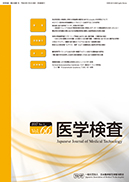Volume 67, Issue 3
Displaying 1-20 of 20 articles from this issue
- |<
- <
- 1
- >
- >|
Original Articles
-
Article type: Original Article
2018Volume 67Issue 3 Pages 281-288
Published: May 25, 2018
Released on J-STAGE: May 30, 2018
Download PDF (1922K) Full view HTML -
Article type: Original Article
2018Volume 67Issue 3 Pages 289-293
Published: May 25, 2018
Released on J-STAGE: May 30, 2018
Download PDF (1243K) Full view HTML -
Article type: Original Article
2018Volume 67Issue 3 Pages 294-298
Published: May 25, 2018
Released on J-STAGE: May 30, 2018
Download PDF (1924K) Full view HTML -
Article type: Original Article
2018Volume 67Issue 3 Pages 299-306
Published: May 25, 2018
Released on J-STAGE: May 30, 2018
Download PDF (5447K) Full view HTML
Technical Articles
-
Article type: Technical Article
2018Volume 67Issue 3 Pages 307-313
Published: May 25, 2018
Released on J-STAGE: May 30, 2018
Download PDF (1841K) Full view HTML -
Article type: Technical Article
2018Volume 67Issue 3 Pages 314-320
Published: May 25, 2018
Released on J-STAGE: May 30, 2018
Download PDF (8785K) Full view HTML -
Article type: Technical Article
2018Volume 67Issue 3 Pages 321-327
Published: May 25, 2018
Released on J-STAGE: May 30, 2018
Download PDF (2343K) Full view HTML -
Article type: Technical Article
2018Volume 67Issue 3 Pages 328-333
Published: May 25, 2018
Released on J-STAGE: May 30, 2018
Download PDF (1854K) Full view HTML -
Article type: Technical Article
2018Volume 67Issue 3 Pages 334-339
Published: May 25, 2018
Released on J-STAGE: May 30, 2018
Download PDF (1876K) Full view HTML
Materials
-
Article type: Material
2018Volume 67Issue 3 Pages 340-346
Published: May 25, 2018
Released on J-STAGE: May 30, 2018
Download PDF (1862K) Full view HTML -
Article type: Material
2018Volume 67Issue 3 Pages 347-352
Published: May 25, 2018
Released on J-STAGE: May 30, 2018
Download PDF (1821K) Full view HTML -
Article type: Material
2018Volume 67Issue 3 Pages 353-359
Published: May 25, 2018
Released on J-STAGE: May 30, 2018
Download PDF (8920K) Full view HTML
Case Reports
-
Article type: Case Report
2018Volume 67Issue 3 Pages 360-365
Published: May 25, 2018
Released on J-STAGE: May 30, 2018
Download PDF (9737K) Full view HTML -
Article type: Case Report
2018Volume 67Issue 3 Pages 366-372
Published: May 25, 2018
Released on J-STAGE: May 30, 2018
Download PDF (7634K) Full view HTML -
Article type: Case Report
2018Volume 67Issue 3 Pages 373-378
Published: May 25, 2018
Released on J-STAGE: May 30, 2018
Download PDF (3644K) Full view HTML -
Article type: Case Report
2018Volume 67Issue 3 Pages 379-383
Published: May 25, 2018
Released on J-STAGE: May 30, 2018
Download PDF (1914K) Full view HTML -
Article type: Case Report
2018Volume 67Issue 3 Pages 384-390
Published: May 25, 2018
Released on J-STAGE: May 30, 2018
Download PDF (14293K) Full view HTML -
Article type: Case Report
2018Volume 67Issue 3 Pages 391-397
Published: May 25, 2018
Released on J-STAGE: May 30, 2018
Download PDF (5595K) Full view HTML -
Article type: Case Report
2018Volume 67Issue 3 Pages 398-402
Published: May 25, 2018
Released on J-STAGE: May 30, 2018
Download PDF (4754K) Full view HTML -
Article type: Case Report
2018Volume 67Issue 3 Pages 403-409
Published: May 25, 2018
Released on J-STAGE: May 30, 2018
Download PDF (16612K) Full view HTML
- |<
- <
- 1
- >
- >|
